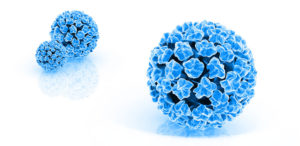Early detection of HPV16-induced tumours
Guidelines for identifying high-risk patients
Patients with condylomata acuminata
The low-risk subtypes 6 and 11 of HPV are thought to be responsible for condyloma acuminata. More rarely, genital warts are linked to increased incidence of cancer in the mouth, throat and anogenital area.
A long-term study of nearly 11.000 patients with condyloma acuminata and 33 years of follow-up has shown that both women and men have a significantly higher risk of developing cancer in the anogenital area as well as in the mouth and throat. Male patients were monitored for an average of 15 years, female patients for an average of 13 years.1

Almost one percent of the population of reproductive age is affected by genital warts. Warts are usually treated externally and locally, surgically if necessary. Condylomas reappear in over one third of cases after treatment. The s2k guideline for HPV-associated lesions of the external genital region and anus cite the following causes of recurrence:
- HPV DNA remaining in the surrounding tissue despite therapy
- Infected tissue wasn’t removed completely or multifocal infection
- Re-infection by an infected partner2
High-risk HPV subtypes are found in over 33% of genital warts in men and almost 56% of genital warts in women. HPV16 which has high oncogenic potential was the most common type. It was found in 16.5% of genital warts3 (see Figure 2).

